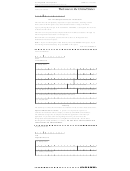Running Records Reading Instruction Page 4
ADVERTISEMENT
How can we use Running Records
Figure 1: Example of a Running Record
taken on the Running Record Sheet
to inform our teaching?
We can use the information we gain from Running Records to determine
if students are:
•
reading fluently or word-by-word reading
•
resorting to using single phonemes to sound out words
•
not attending to meaning
•
ignoring first-letter cues or only using first-letter cues and not
attending to detail in words
•
not self-correcting errors
•
re-reading
•
problem-solving.
Running Records show the emphases and neglects of our classroom
reading programs and help us plan how to use this information to address
students’ needs.
(Taken from Clay, M.M., p 23)
How can we address students’ needs?
At the end of a Running Record, or during classroom reading time, teachers could use some of the following prompts to help students to problem-solve:
To help students use meaning, say:
To help students use structure, say:
To help students use visual information, say:
•
Did that make sense?
•
Did that sound right?
•
Did that look right?
•
Look at the picture and think what would
•
Can we say it like that?
•
What could you try?
make sense.
•
Read it again and think what would sound right.
•
Do you know a word that starts with
•
Read it again and think what would make sense.
those letters?
•
You said ____ did that sound right?
•
You said ____ did that make sense?
•
Do you know a word like that?
•
What do you think it could be?
To help students check on themselves
To help students self-correct, say:
To help students cross-check, say:
(self-monitor) say:
•
I like the way you found out what was wrong all
•
It could be ____ that would make sense, but
by yourself.
•
There was a tricky part there – you find it.
look at ____
•
You made a mistake on that page (or in that
•
Are you right?
•
Could it be ____ or ____ or ____ ?
sentence) can you find it?
•
You made a mistake there, try that again.
•
Check it – does it look right and sound right
•
Nothing!!! Allow time for the child to self-correct.
to you?
(Adapted from Clay, M.M. )
For further information
Clay, M.M. 2001, Change over time in children’s literacy development. Heinemann, Portsmouth N.H.
Clay, M.M. 2000, Running Records: for classroom teachers. Heinemann, Auckland.
Fountas, I.C. and Pinnell, G.S. 1996, Guided Reading: good first reading for all children. Heinemann, Portsmouth N.H.
Please visit our website at:
4 |
Running Records Consultative Draft February 2012
ADVERTISEMENT
0 votes
Related Articles
Related forms
Related Categories
Parent category: Education
 1
1 2
2 3
3 4
4








